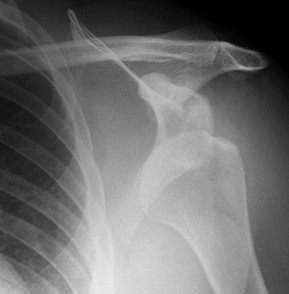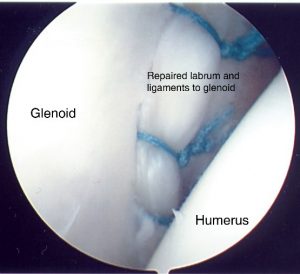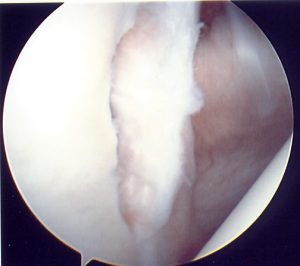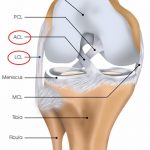Bears QB undergoes shoulder labrum surgery; likely to be in training camp

A fall on an outstretched arm can cause an anterior shoulder dislocation, shown in the X-ray, and tear the labrum and ligaments connecting the humeral head (ball) and glenoid (socket) from the glenoid.
It was just the fourth game of the season and six plays in when Chicago Bears quarterback, Mitch Trubisky, fell on his outstretched left arm after he was sacked by Minnesota Viking’s defensive end, Danielle Hunter. Trubisky left the game and would miss the next the next game for what the press reported was a dislocated shoulder and slight tear of the labrum. An MRI confirmed the injury and since it was Trubisky’s non-throwing shoulder, team physicians allowed him to play in subsequent weeks with a shoulder brace. During the off-season, Trubisky underwent surgery to repair his torn labrum. According to the Bears, they expect Trubisky to be ready by the start of training camp in late July, about six months after his surgery.
During his 18 years of practice and as a high school team and club physician, arthroscopic shoulder specialist, Dr. Steven Chudik with the Shoulder, Knee and Sports Medicine Injury Clinic in Westmont, Ill., has regularly seen and treated athletes with shoulder dislocations and labrum injuries like Trubisky’s.
According to Dr. Chudik, when an athlete dives or falls and the arm is forced upwards and outward away from the body, like Trubisky, it is not uncommon to dislocate their shoulder and tear their labrum. “This mechanism of injury pushes the humeral head (the ball at the top of your upper arm bone) out the front of your glenoid (shoulder socket). When a shoulder dislocates, the ligaments connecting the humeral head and glenoid usually tear off the front of the glenoid along with the labrum (a fibrocartilaginous soft-tissue surrounding the rim of the glenoid “socket” to help hold/stabilize the humeral head “ball” in the glenoid). This injury is called a labral or Bankart tear,” Dr. Chudik explained. “Fractures to the humeral head (Hill Sachs Lesion) and glenoid (Bony Bankart), rotator cuff tears, and stretch injuries to nerves of the arm also can occur from a shoulder dislocation. Fortunately for Trubisky, it appears only his labrum was injured,” Dr. Chudik added.
Shoulder dislocations are serious injuries. If a shoulder dislocates during a sporting event, the team’s athletic trainers, often with the assistance of the team physician, act quickly to take a brief history of the injury, examine the athlete, ensure no other injuries have occurred and quickly reduce (“put”) the shoulder back in place.
Dr. Chudik pointed out that regardless where a dislocated shoulder occurs—during an athletic competition, a fall at home, or a traumatic accident, “quick medical response is important to reduce the shoulder before the shoulder muscles start to spasm and tense, and to restore blood flow to the humeral head.”

Image shows the Bankart tear after it was arthroscopically repaired by Dr. Steven Chudik.

Arthroscopic image looking inside the shoulder shows a Bankart tear caused by a shoulder dislocation.
He also stressed the importance to be evaluated as soon as possible by an orthopaedic surgeon to determine the extent of the injury. This includes a physical exam of the shoulder, X-ray, magnetic resonance imaging (MRI), and sometimes a computed tomography (CT) scan to evaluate the extremity for nerve, blood vessel, ligament, bone (fractures) and rotator cuff injuries.
“After the shoulder is reduced, physical therapy helps restore motion, strength, position sense and shoulder function,” Dr. Chudik noted. “Some in-season athletes may return to play in a brace after several weeks of an appropriate rehabilitation program like Trubisky. However, braces restrict motion and may hinder performance or prevent return to certain sports and positions,” he added.
Dr. Chudik explained that without surgery to repair torn shoulder ligaments and labrum, athletes younger than age 25 have an 80 to 100 percent chance of a repeat dislocation and therefore, should strongly consider surgical repair before the next season to prevent re-injury.
If, after a careful assessment of the shoulder and imaging, Dr. Chudik determines surgery is necessary, he prefers to arthroscopically repair the labral tear and any other stabilizing structures—capsule ligaments, rotator cuff, or bone, etc.—through several very small incisions to accommodate an arthroscopic camera and instruments and allow him to see and restore shoulder stability. Following surgery, the arm is in a sling for six weeks followed by four to six months of physical therapy to restore range of motion in the shoulder and regain strength.
Despite appropriate surgery, athletes who return to contact sports, like Trubisky, are still at risk for re-injury. “They dislocated and tore their labrum when it was normal, so they can do it again,” Dr. Chudik explained.
To lessen this risk, Dr. Chudik developed a new dynamic shoulder stability exercise program along with testing to treat his patients after their arthroscopic shoulder surgeries. The program is designed to help ensure a safe return to activities and decrease the risk for re-injury. “I am currently collecting data on our results. To my knowledge, I am the first orthopaedic surgeon in the country doing this type of post-surgical testing for shoulder surgery patients and hopefully the result will prove beneficial” Dr. Chudik said.
If you, or someone you know injured their shoulder or had surgery for a shoulder dislocation or torn labrum and would like to be evaluated and/or tested, he/she can schedule an appointment on Dr. Chudik’s website at https://www.stevenchudikmd.com/schedule-online/, email him at contactus@chudikmd.com, or call 630-324-0402.








